When making beef jerky, the type of meat you choose is critical. After all, it’s the main ingredient, and the quality of the final product depends on it. While you can use nearly any cut of beef, some are better suited to the task than others. With so many different cuts available, knowing which is best for beef jerky can be challenging. In this article, we’ll take a closer look at the other cuts of beef and examine which ones are the best for making mouthwatering beef jerky. From tenderloin to flank steak, we’ll explore the pros and cons of each option so you can make an informed choice and create the perfect irregular every time.
Best Cut for Beef Jerky
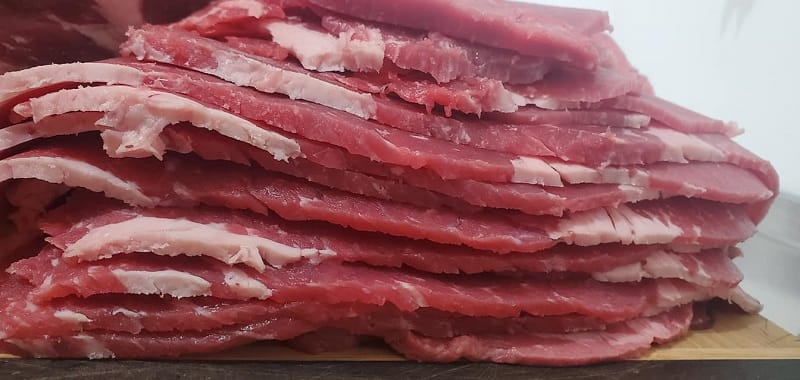
When it comes to making beef jerky, choosing the right cut of meat is essential for achieving the perfect flavor and texture. The best cuts of beef for jerky are the top round and bottom round roasts, which are lean, flavorful, and ideal for drying. Other cuts, such as the blade lifter and pectoral meat, can also be used, but it’s important to select cuts that have minimal fat, as fat does not dry out and can spoil the flavor of the jerky.
Additionally, the eye of round roast is a popular choice due to its distinct muscle fibers and little fat, making it easy to slice and dry out. When shopping for meat for beef jerky, it’s important to look for lean cuts and trim any excess fat before beginning the jerky-making process. With the right cut of meat and proper preparation, anyone can make delicious beef jerky at home.
Making great-tasting jerky requires the perfect cut of beef, where things can get tricky. Each of these beef cuts has its unique advantages and drawbacks, so let’s take a closer look at each one.
Bottom Round
The bottom round is one of the most affordable beef cuts, making it an attractive choice for jerky. The downside is that it can be somewhat challenging, so marinating it before making jerky is best.
Eye of Round
Eye of round is a leaner cut of beef than the bottom band, so it’s a better choice if you’re looking for a jerky with a tender texture. However, it can be somewhat expensive, so it’s best to save this cut for special occasions.
Flank Steak
Flank steak is a popular choice for jerky because it’s relatively tender and easy to work with. However, it tends to be a bit more expensive than the bottom round.
Short Loin
The short loin is another lean cut of beef, so it’s a great choice for jerky. The downside is that it can be more difficult to work with than flank steak due to its smaller size.
Sirloin Tip (Knuckle)
The sirloin tip (knuckle) is a great cut for beef jerky. It’s lean and tender, making it perfect for jerky. The fat content is lower than other cuts, so there’s less risk of your jerky becoming too greasy. The sirloin tip also has a lot of flavors, so you’ll be sure to enjoy it.
Lifter
The lifter is another great cut for beef jerky. It’s lean but has a little more fat content than the sirloin tip. This fat helps to keep the jerky juicy and flavorful. The lifter is also great for cutting thin slices, which will help your jerky cook evenly.
Top Round (London Broil)
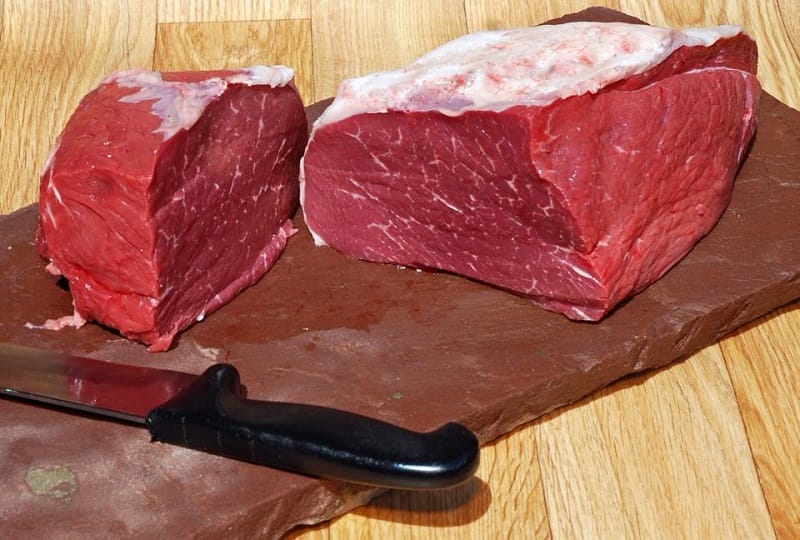
The top round (London broil) is also a great cut for beef jerky. It’s a lean cut that is easy to slice into thin strips. The top round will give you good flavor but won’t be as tender as the sirloin tip or the lifter.
Pectoral
Finally, the pectoral cut is an awesome cut for beef jerky. It’s a lean cut with a lot of flavors. The pectoral is also very tender, making it ideal for jerky. It’s also a great choice if you’re looking for jerky that has a little more fat content.
Best Meat For Beef Jerky In Smoker
The best meat to use when making beef jerky in a smoker is lean cuts like beef round or sirloin tip roast. These cuts are low-fat and provide a chewy texture that jerky lovers crave. Although traditional jerky is made from beef, it’s worth experimenting with other types of meat like pork, lamb, turkey, and even game animals such as deer, bear, caribou, and moose.
Read more:
How to Choose the Best Cut of Meat for Beef Jerky?
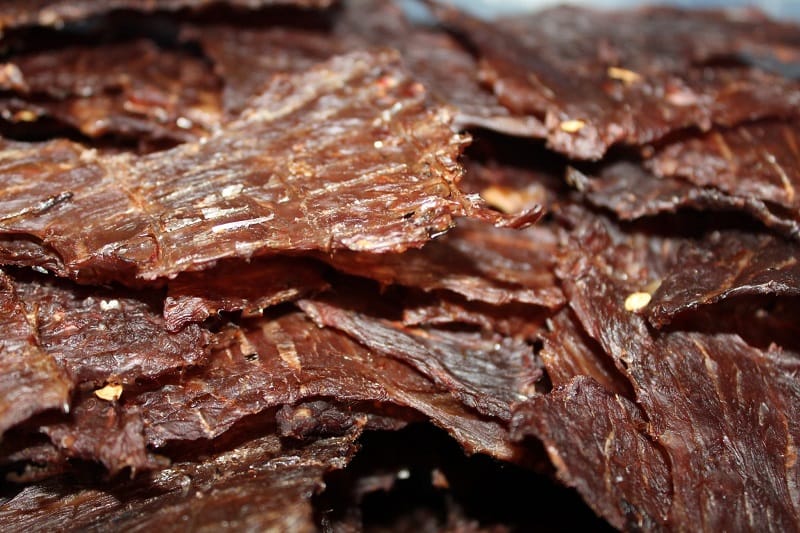
Choosing the right cut of meat for beef jerky is an important step in making a delicious snack. Whether making your beef jerky or purchasing it pre-made, you want to ensure you are selecting the right cut of beef for the best results. Here are some tips to help you choose the best cut of meat for beef jerky.
When selecting the cut of meat for beef jerky, look for lean cuts with minimal fat. The fat can make the jerky greasy and spoil the flavor. The best cuts for beef jerky are flank steak, top round, and bottom round. These cuts are lean and have a good flavor.
Be sure to trim off any visible fat before slicing the meat. This will help ensure your jerky has a nice texture and flavor. If you are making your own beef jerky, consider investing in a good meat slicer. This will make it easier to get the desired thickness for the best results.
Something to keep in mind when selecting the right cut of meat for beef jerky is that the meat will shrink during the drying process. So, it’s essential to select a cut that is slightly bigger than what you need. This will ensure that you end up with enough beef jerky to enjoy.
When selecting the cut of meat for beef jerky, you’ll also want to consider the marinade. The marinade adds flavor to the beef jerky and helps tenderize it. Flank steak and top rounds are great beef jerky cuts because they absorb the marinade more readily.
Finally, always make sure to select freshly cut meat for beef jerky. If you purchase pre-packaged meat, check the expiration date to ensure it is still fresh. The fresher the meat, the better the flavor and texture of the jerky will be.
Why Is It Important To Choose A Cut For Beef Jerky With Very Little Fat?
When making beef jerky, choosing the right cut of meat with very little fat is incredibly important. Fat adds a lot of extra calories and can make the finished product greasy while reducing the jerky’s shelf-life.
Fat can cause jerky to become rancid if it is not stored correctly. This means that the fat in the beef can cause the jerky to spoil quickly, making it unsafe to eat. Fat can also cause the jerky to become overly greasy, which can detract from the overall flavor and texture.
Another reason why it is important to choose a cut of beef with very little fat is because it allows for better seasoning. Fat absorbs more of the spices and seasonings you put on the beef, leading to an uneven flavor profile. With lean cuts, the flavor of the seasonings can be more evenly distributed, giving the jerky a more uniform and consistent flavor.
Finally, lean cuts of beef will also yield more jerky per pound than fattier cuts. When making beef jerky, it is important to maximize yield and minimize waste; lean cuts of beef are the best way to do this. The leaner cuts of meat will also be less likely to shrink as they dry, meaning that your finished product will be larger than if you used a fattier cut.
Are There Any Health Benefits Associated With Eating Homemade Beef Jerky?
For starters, beef jerky is an excellent source of lean protein. Protein is an essential part of a balanced diet and helps build muscle and keep us feeling full for longer. Eating homemade beef jerky can be a great way to get a protein boost without the added fat and calories of many other snacks.
Homemade beef jerky is also low in sodium. Since most of the sodium in beef jerky comes from the curing process, making your jerky at home can reduce the sodium content significantly. This can help to lower the risk of high blood pressure, stroke, and heart disease, among other conditions associated with high sodium consumption.
Homemade beef jerky can also be a great source of vitamins and minerals. Beef jerky made from grass-fed beef is high in zinc, essential for immune function and wound healing. It also contains iron, which helps the body produce red blood cells, and Vitamin B12, which helps to maintain a healthy nervous system. Homemade beef jerky can also contain a range of other vitamins and minerals, including vitamins A, C, and E.
Finally, homemade beef jerky is also a great source of healthy fats. Beef jerky from grass-fed beef is high in omega-3 fatty acids, which are essential for proper brain function and heart health. Eating beef jerky can also help reduce inflammation associated with several chronic illnesses.
How to Make Beef Jerky?
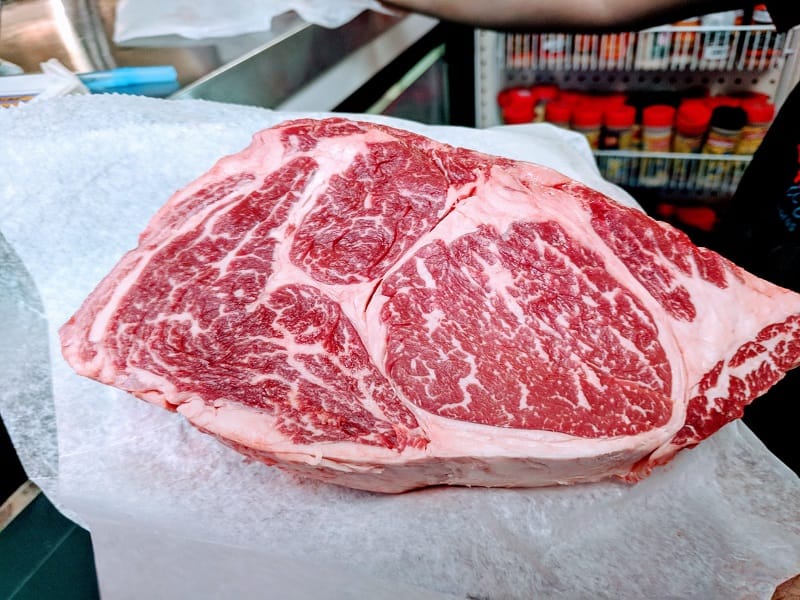
Making beef jerky is a simple and straightforward process. All you need is some lean beef, a few basic ingredients, and a few supplies. Here’s how to make beef jerky at home in four easy steps:
- Trim the fat from the beef: Trim as much fat as possible. Fat does not dry properly and can cause the jerky to spoil faster.
- Slice the beef: Slice the beef into strips that are no more than ¼ inch thick. The thinner the slices, the quicker they will dry.
- Mix the marinade: In a medium bowl, mix the marinade ingredients. This marinade is what will give the jerky its flavor. You can use a store-bought marinade or make your own. Combine one cup of soy sauce, Worcestershire sauce, and one tablespoon of liquid smoke for a classic jerky taste.
- Marinate the beef: Place the beef strips in a large container or bowl and pour the marinade over them. Make sure the beef is evenly coated. Cover the container and place it in the refrigerator for 8-24 hours, depending on the thickness of the beef.
- Dry the beef: Preheat your oven to its lowest setting (usually around 175°F). Line two baking sheets with parchment paper and place the beef strips on the parchment paper. Place the baking sheets in the oven and bake for 3-4 hours, flipping the beef strips once halfway through the cooking time. Once the jerky is done, let it cool before consuming it.
How to Store Beef Jerky?
When storing beef jerky, your number one concern should be keeping it fresh. The best way to do this is by keeping it dry and cool. The ideal storage temperature for beef jerky is between 40°F and 50°F. This can be accomplished by storing it in a refrigerator or a cool, dark place.
The next step is to remove any excess moisture from the beef jerky. Moisture can cause the jerky to spoil and become inedible. Place the jerky in a paper towel and leave it in the refrigerator for a few hours to remove moisture. The paper towel will absorb any excess moisture and prevent spoilage.
Once the beef jerky has been properly dried, store it in an airtight container. This could be a plastic bag, glass, jar, or even a vacuum-sealed bag. If you use a plastic bag, squeeze out as much air as possible before sealing it. This will help keep oxygen out, so the jerky doesn’t become stale or rancid.
Finally, always store your beef jerky away from other food items. This will help prevent cross-contamination and keep your jerky safe and flavorful for longer.
Different Kinds Of Jerky Steak
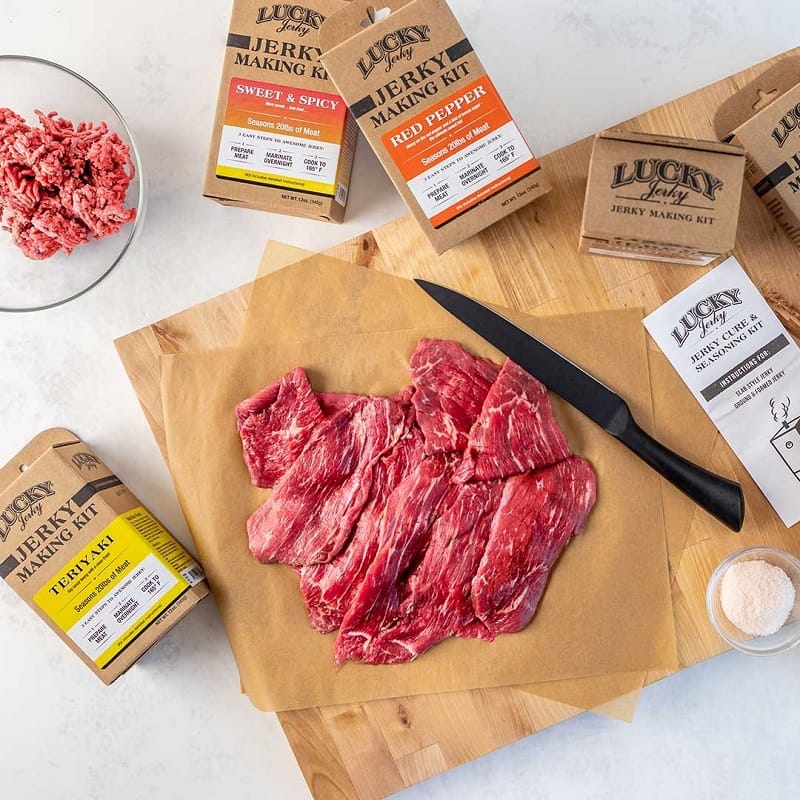
If you’re looking to switch up your usual jerky steak routine, there are plenty of different kinds of jerky steak to choose from. Here’s a look at some of the most popular varieties.
Jerky BBQ Steak
This is a classic jerky steak with a smoky, sweet sauce made from molasses, brown sugar, and BBQ spices. It’s a great flavor for those looking for a traditional jerky steak experience.
Traditional Jerky Steak
This type of jerky steak is one of the most well-known varieties. It’s made from lean cuts of beef, lightly seasoned with salt and pepper, and then sliced into thin strips. It’s a great choice for a simple but satisfying snack.
Hawaiian Beef Jerky
This type of jerky steak is marinated in pineapple juice, soy sauce, and other spices. It’s a great way to get an island-inspired flavor in your jerky steak.
Teriyaki Jerky Steak
This jerky steak is marinated in a sweet and savory teriyaki sauce. It’s a great option for those looking for a unique flavor in their jerky steak.
Lemon-Peppered Jerky Beef
This type of jerky steak is marinated in a mixture of lemon juice, pepper, garlic, and other spices. It’s a great way to give your jerky steak a zesty kick.
Honey-Glazed Beef Jerky
This jerky steak is marinated in a sweet, savory glaze made from honey, soy sauce, and other spices. It’s a great way to get a unique flavor in your jerky steak.
Peppered Beef Jerky
This type of jerky steak is marinated in black pepper, garlic, and other spices. It’s a great way to get a spicy kick in your jerky steak.
What Seasoning And Marinade Options Are Best For Beef Jerky?
Regarding beef jerky, the right seasoning and marinade can make all the difference. So, what are the best seasoning and marinade options for beef jerky?
When it comes to seasoning beef jerky, the most popular choices are sea salt, garlic powder, onion powder, and black pepper. These spices provide a lot of flavor without overpowering the meat’s natural flavor. But plenty of other spice mixes are available, including cayenne pepper, smoked paprika, curry powder, and chili powder.
Once you’ve chosen your spices, it’s time to move on to marinades. Marinades are used to tenderize and flavor your beef jerky. Popular marinade options include soy sauce, Worcestershire sauce, teriyaki sauce, and balsamic vinegar. You can also experiment with different combinations of these ingredients to create your unique marinade.
The longer you marinate your beef jerky, the more flavorful it will be. You can marinate your beef jerky overnight or for up to a few days. Just make sure to refrigerate the beef jerky while it’s marinating.
What Is The Ideal Temperature And Time Range For Dehydrating Beef Jerky?
When making delicious beef jerky, there are certain temperature and time requirements. The ideal temperature range for dehydrating beef jerky is between 160-165 degrees Fahrenheit. This ensures that the meat reaches an internal temperature of at least 160 degrees, which is important for food safety.
The drying process should begin at this temperature range for the first 3 hours before being turned down to 145F. This temperature range should be maintained for the next few hours until the meat has fully dehydrated.
The recommended time range for dehydrating beef jerky is between 8 to 12 hours, depending on how thick the meat is sliced and personal preference.
What Types Of Meat Should Be Avoided When Making Beef Jerky?
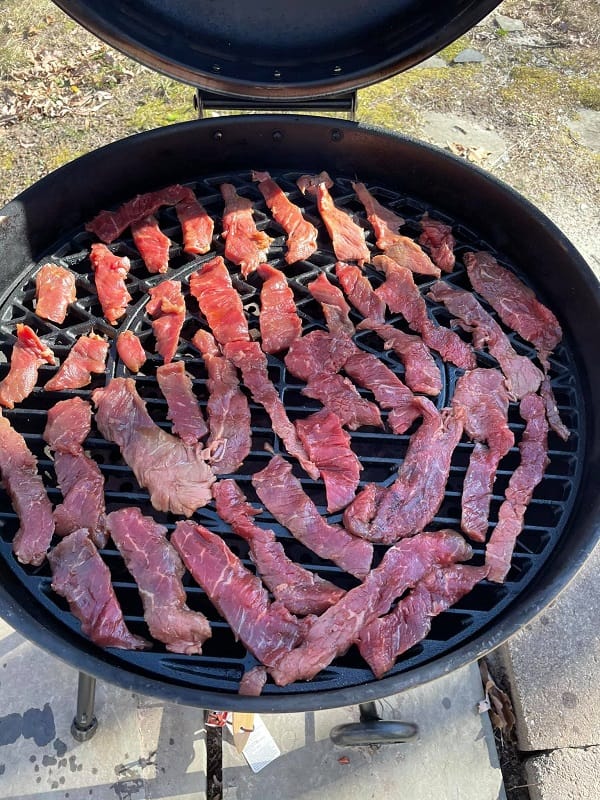
While all types of meat can be used to make jerky, some types of meat are best avoided when making beef jerky.
- First and foremost, it is important to avoid any meat that has a high-fat content. Fat will cause the jerky to spoil quickly, and it will also adversely affect the taste. Additionally, beef fat tends to be quite greasy, and this grease will both reduce the shelf life of the jerky and leave an unpleasant aftertaste. Therefore, it is generally best to select lean cuts of beef.
- Second, it is best to avoid processed meats. Processed meats, such as deli meats, are high in sodium and preservatives, which can hurt the taste and texture of the jerky. Some processed meats may also contain MSG, which can affect the flavor.
- Finally, it is best to avoid game meats, such as venison and elk. While these meats can make excellent jerky, they require special preparation and seasoning techniques to ensure the best results. Additionally, due to the size of game animals, it can be difficult to find cuts of meat suitable for making jerky.
What Are Some Common Mistakes To Avoid When Making Beef Jerky At Home?
But like any other cooking project, there can be some common pitfalls to avoid if you want to make the best beef jerky possible.
- Not Trimming the Fat – Before you start drying out your beef, make sure you trim away any unnecessary fat. Not only will it make your beef jerky healthier, but it will also make it easier to dry out.
- Not Marinating the Beef – To get the most flavor out of your beef jerky, it’s important to marinate it for at least a few hours. This will help the spices to penetrate the beef and give it that delicious jerky flavor.
- Not Drying the Beef Long Enough – If you don’t dry your beef jerky long enough, it could end up being too soft or too chewy. Ensure you give it enough time to dehydrate until it’s completely dry and snaps when you break it.
- Not Letting It Cool – After your beef jerky is finished in the dehydrator, it’s important to let it cool down for at least an hour. This will help it to solidify and prevent it from getting too sticky.
- Not Storing It Properly – Make sure you store your beef jerky in an airtight container and in a cool and dry place. Otherwise, it could not go good faster or become too soft or chewy.
FAQs About Best Cut for Beef Jerky
Is Eye Of Round Another Good Option For Making Beef Jerky?
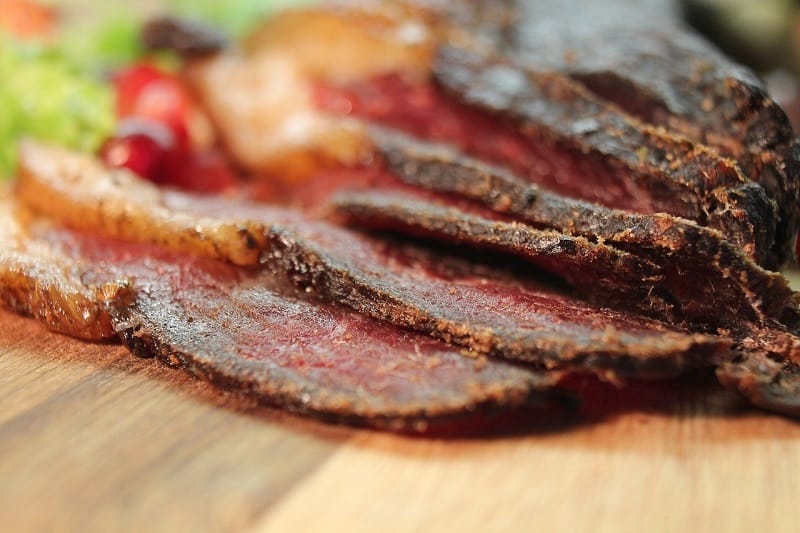
As per factual data, the eye of the round is considered the most tender cut among all the sub-primal cuts from the round. It is very lean and has very little fat, essential for making beef jerky. Although it is a large cut, trimming and slicing it into thin strips is easy. Many jerky recipes call for the eye of the round as the preferred cut, and professional jerky makers also recommend it. However, top round and bottom round are also great options if the eye of round is not readily available. In short, the eye of round is another great option for making beef jerky, and one can expect flavorful and tender jerky by selecting it.
How Thick Should The Slices Of Meat Be For Making Beef Jerky?
When making beef jerky, the thickness of the meat slices is crucial for achieving the perfect texture and flavor. Generally, slicing the beef between 1/8 and 1/4 inch thick is recommended. However, there is no set rule for this, as personal preference plays a significant role in the thickness of the meat slices. Ensuring that the jerky slices dehydrate evenly is essential, so cutting the meat with the grain and keeping the thickness consistent is essential. When slicing the meat, it’s advisable to freeze it for about an hour to make it easier to handle and cut. Protective gloves are also recommended, as slicing through the slightly frozen meat can be challenging. In conclusion, when it comes to making beef jerky, the perfect thickness of meat slices depends on personal preference, but generally, slices around 1/4 inch thick are recommended.
How Long Should Beef Jerky Be Dried For Optimal Results?
According to factual data, dry jerky should have a curing time between 4-5 hours in a dehydrator to ensure it has lost two-thirds of its moisture. Thinner strips will take less time, and precooked meat will dry more quickly. Once dried, a pound of meat is typically reduced to about 4 ounces. To maintain the best flavor and increase shelf life, storing the dehydrated beef jerky at room temperature in a sealed container is best. The shelf life of jerky is influenced by its storage method, so proper storage is key. Following these recommended guidelines can achieve optimal results when making beef jerky at home.
Conclusion
Now that you know the best cuts for beef jerky, it’s time to get cooking! You can make delicious and flavorful beef jerky at home with a little bit of preparation. All you have to do is get the right cut of beef, season it to your liking, and get to jerky-making. Enjoy!
I hope this was helpful! If you have any other questions about the best cut for beef jerky, feel free to leave them in the comments below.
References:
- https://www.fsis.usda.gov/food-safety/safe-food-handling-and-preparation/meat/jerky
- https://nchfp.uga.edu/how/dry/jerky.html

Hey readers! Chip Holland here, and I’m a Manager of this website. My passion for writing about it only matches my passion for BBQ. Follow my blog for mouth-watering recipes, tips, and tricks for the perfect smoke, grill, and BBQ. I’m sure you won’t be disappointed!
